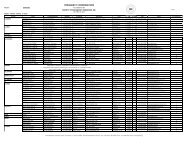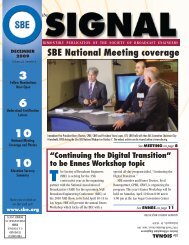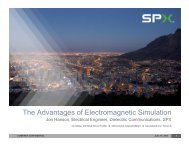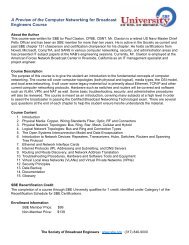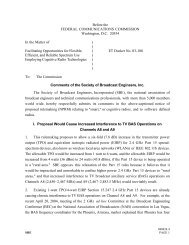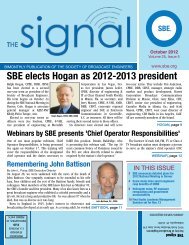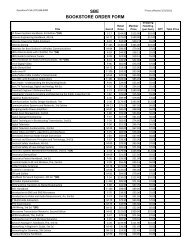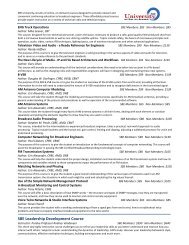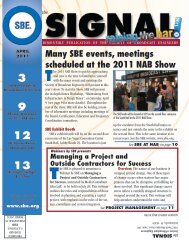Thomas re-elected SBE President - Society of Broadcast Engineers
Thomas re-elected SBE President - Society of Broadcast Engineers
Thomas re-elected SBE President - Society of Broadcast Engineers
Create successful ePaper yourself
Turn your PDF publications into a flip-book with our unique Google optimized e-Paper software.
Wi<strong>re</strong>less Microphones at<br />
944-952 MHz; <strong>SBE</strong>’s View<br />
BY Chris Imlay, CBT<br />
<strong>SBE</strong> General Counsel<br />
he inevitable fallout <strong>of</strong> the<br />
<strong>re</strong>allocation <strong>of</strong> television<br />
channels 52-69 (698-806 MHz,<br />
cimlay@sbe.org<br />
commonly known as the “700 MHz<br />
band”) for public safety and commercial broadband use has been<br />
a seve<strong>re</strong> <strong>re</strong>duction in available spectrum for Part 74, Subpart H<br />
Low Power Auxiliary (LPA) operation. This in turn has spawned a<br />
scramble for spectrum on which licensed wi<strong>re</strong>less microphones<br />
and other LPA facilities can operate. The<strong>re</strong> a<strong>re</strong> p<strong>re</strong>sently no good<br />
solutions to this problem, and the FCC has not, to date, proposed<br />
to allocate any <strong>re</strong>placement spectrum for LPA operation. The<strong>re</strong> a<strong>re</strong>,<br />
however, some <strong>re</strong>ally bad solutions being pursued and implemented<br />
by certain equipment <strong>re</strong>tailers and leasing companies.<br />
Indeed, the FCC has, as the <strong>re</strong>sult <strong>of</strong> <strong>re</strong>quests from public safety<br />
organizations and others, <strong>re</strong>cently awakened to the fact that the<strong>re</strong><br />
a<strong>re</strong> many hund<strong>re</strong>ds <strong>of</strong> illegally operated wi<strong>re</strong>less microphones<br />
in <strong>re</strong>gular use. The problem is akin to the unlicensed CB radio<br />
problem in the 1970s: the FCC has absolutely no ability to enforce the<br />
Communications Act or its own rules, which <strong>re</strong>qui<strong>re</strong> licenses for Part<br />
74 wi<strong>re</strong>less microphones, because the magnitude <strong>of</strong> the unlicensed,<br />
unlawful operation far outstrips the enforcement <strong>re</strong>sources <strong>of</strong> the<br />
Commission. This fact, which broadcast engineers have known<br />
about for many years (because their legal, licensed and coordinated<br />
LPA operations have been disrupted by illegal, unlicensed wi<strong>re</strong>less<br />
microphones operating unp<strong>re</strong>dictably) has been brought to the<br />
Commission’s attention by public safety entities and others. Now,<br />
at the eleventh hour befo<strong>re</strong> the DTV transition date, the FCC has<br />
finally proposed in WT Dockets 08-166 and 08-167 to prohibit,<br />
after the end <strong>of</strong> the DTV transition, the operation <strong>of</strong> any LP Auxiliary<br />
facilities in the 700 MHz band, and as well the manufactu<strong>re</strong>, sale,<br />
importation, or marketing <strong>of</strong> LP Auxiliary devices that operate at<br />
700 MHz. In an order accompanying the NPRM in that proceeding,<br />
the FCC al<strong>re</strong>ady imposed a f<strong>re</strong>eze on all new 700 MHz LP Auxiliary<br />
applications. It is a simple matter to see that the comp<strong>re</strong>ssion <strong>of</strong> all<br />
LP Auxiliary facilities, and especially wi<strong>re</strong>less microphones (“WMs”)<br />
into the television broadcast channels below 698 MHz is ext<strong>re</strong>mely<br />
likely, if not inevitable, after February 17, 2009. This, coupled with:<br />
(1) the Commission’s <strong>re</strong>lentless effort to permit so-called “white<br />
spaces” devices in those same <strong>re</strong>maining television channels; (2) the<br />
migration <strong>of</strong> Class A and LPTV facilities into those same channels; (3)<br />
the failu<strong>re</strong> <strong>of</strong> the FCC to provide or even propose any <strong>re</strong>placement<br />
spectrum for licensed LPAs at all; and (4) the exceptionally large<br />
volume <strong>of</strong> unlicensed (and unlawful) operation <strong>of</strong> Part 74 WMs,<br />
makes the situation far mo<strong>re</strong> challenging than even the most<br />
dedicated <strong>SBE</strong> f<strong>re</strong>quency coordinator could handle without spectrum<br />
conflicts.<br />
The <strong>re</strong>sponse <strong>of</strong> some vendors <strong>of</strong> LP Auxiliary WMs to this<br />
challenge has not been at all encouraging. Manufactu<strong>re</strong>rs a<strong>re</strong><br />
producing and selling WMs that operate in the 944-952 MHz Aural<br />
<strong>Broadcast</strong> Auxiliary Services (BAS) band. This, they a<strong>re</strong> perfectly<br />
entitled to do. Section 74.802 <strong>of</strong> the Commission’s rules permits<br />
broadcast licensees and broadcast networks to operate LPA devices<br />
including WMs in the 950 MHz Aural BAS band. However, it is only<br />
broadcast licensees and broadcast network entities that can use<br />
this band, cable television operators, motion pictu<strong>re</strong> producers and<br />
television program producers a<strong>re</strong> not eligible to use any BAS band for<br />
LPA operation except unoccupied television channels.<br />
The problem, though, is that <strong>re</strong>tailers and dealers <strong>of</strong> equipment<br />
<strong>of</strong> even the most scrupulous manufactu<strong>re</strong>rs have actively marketed<br />
these products to ineligible entities, and their marketing has been<br />
accompanied by serious mis<strong>re</strong>p<strong>re</strong>sentations and lack <strong>of</strong> candor<br />
<strong>re</strong>garding the obligations <strong>of</strong> users <strong>of</strong> the devices. Of course, the<strong>re</strong><br />
is no point <strong>of</strong> sale control <strong>of</strong> radio transmitters. The FCC has never<br />
imposed such. That is p<strong>re</strong>cisely why a lot <strong>of</strong> church choirs, theaters,<br />
hotel confe<strong>re</strong>nce rooms, schools, and just about anywhe<strong>re</strong> the<strong>re</strong><br />
a<strong>re</strong> performing arts, have all acqui<strong>re</strong>d LPA WMs (most perfectly<br />
innocently, unawa<strong>re</strong> <strong>of</strong> any <strong>re</strong>gulatory and licensing obligations<br />
imposed by the FCC). Neither a<strong>re</strong> the<strong>re</strong> clear marketing <strong>re</strong>strictions<br />
in the equipment authorization rules <strong>of</strong> the Commission that apply to<br />
<strong>re</strong>tailers or leasing companies.<br />
Recently, a company called Location Sound Corp., in their<br />
publication called The Production Sound Report for Summer/Fall<br />
2008 carried an article called “Important RF Spectrum News.” The<br />
first two paragraphs <strong>of</strong> this article <strong>re</strong>ad as follows:<br />
Lectrosonics and other pr<strong>of</strong>essional quality wi<strong>re</strong>less<br />
microphone manufactu<strong>re</strong>rs such as Shu<strong>re</strong> and Sennheiser a<strong>re</strong><br />
now delivering new RF products designed to operate in the 944<br />
MHz broadcast range. This little known a<strong>re</strong>a <strong>of</strong> UHF spectrum is,<br />
for the most part, wide-open and available for production use.<br />
Most UHF wi<strong>re</strong>less microphones in the United States a<strong>re</strong><br />
manufactu<strong>re</strong>d in the Part 74 broadcast bands, from 470 MHz<br />
-806 MHz. Part 74 is the FCC <strong>re</strong>gulation section that assigns this<br />
spectrum for broadcast and motion pictu<strong>re</strong> production. The<strong>re</strong><br />
is, however, a lesser known chunk <strong>of</strong> Part 74 between 944 MHz<br />
and 952 MHz – an 8 MHz band also known as the STL (Studioto-Transmitter<br />
Link) (sic). Little used and unaffected by the DTV<br />
changes, this band is allowed for production use under the same<br />
<strong>re</strong>gulations as the <strong>re</strong>gular UHF wi<strong>re</strong>less microphones.<br />
The article goes on to describe the 944-952 MHz band as “largely<br />
unused” and “less crowded than the UHF TV band.” The 950 MHz<br />
Aural BAS band is, effectively, being portrayed as an available band<br />
for anyone to operate displaced wi<strong>re</strong>less microphones that will<br />
have to vacate 700 MHz. In fact, the article <strong>re</strong>cited an instance <strong>of</strong> an<br />
installation by Location Sound Corporation <strong>of</strong> 944 MHz Sennheiser<br />
transmitters at a show at Universal Studios.<br />
<strong>SBE</strong>, as <strong>re</strong>aders <strong>of</strong> this column well know, advocates the inte<strong>re</strong>sts<br />
<strong>of</strong> licensed users <strong>of</strong> BAS spectrum and provides volunteer BAS<br />
spectrum f<strong>re</strong>quency coordination. The active marketing, sale, or<br />
6 the SIGNAL



